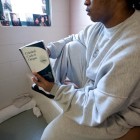

An 11-year-old denied making a threat and was allowed to return to school. Tennessee police arrested him anyway.
|
In late September, Torri was driving down the highway with her 11-year-old son Junior in the back seat when her phone started ringing.
It was the Hamilton County Sheriff’s deputy who worked at Junior’s middle school in Chattanooga, Tennessee. Deputy Arthur Richardson asked Torri where she was. She told him she was on the way to a family birthday dinner at LongHorn Steakhouse.
“He said, ‘Is Junior with you?’” Torri recalled.
Earlier that day, Junior had been accused by other students of making a threat against the school. When Torri had come to pick him up, she’d spoken with Richardson and with administrators, who’d told her he was allowed to return to class the next day. The principal had said she would carry out an investigation then. ProPublica and WPLN are using a nickname for Junior and not including Torri’s last name at the family’s request, to prevent him from being identifiable.
When Richardson called her in the car, Torri immediately felt uneasy. He didn’t say much before hanging up, and she thought about turning around to go home. But she kept driving. When they walked into the restaurant, Torri watched as Junior happily greeted his family.
Soon her phone rang again. It was the deputy. He said he was outside in the strip mall’s parking lot and needed to talk to Junior. Torri called Junior’s stepdad, Kevin Boyer, for extra support, putting him on speaker as she went outside to talk to Richardson. She left Junior with the family, wanting to protect her son for as long as she could ...

Experts Offer Strategies for Preventing Child Welfare and Juvenile Justice Crossover
|
“We knew the pathway existed,” Shay Bilchick said during the opening of Preventing Youth from Crossing Over Between the Child Welfare and Juvenile Justice Systems, a webinar held Wednesday by the National Training & Technical Assistance Center, a program of the Office of Juvenile Justice and Delinquency Prevention. As a prosecutor working the family court circuits in Florida, Bilchik -- now the founder and director of the Center for Juvenile Justice Reform (CJJR) at Georgetown University’s Public Policy Institute -- noted an apparent connection between child abuse and neglect and delinquency cases, referring to such crossover youth as a “challenging” population.
Shortly after Bilchik joined the Public Policy Institute in 2007, the Center for Juvenile Justice Reform and Casey Family Programs worked together to create the Crossover Youth Practice Model. This model stems from the Juvenile Justice and Child Welfare Integration Breakthrough Series Collaborative, developed in the mid-1990s by the Associates in Process Improvement, Casey Family Programs and the Institute for Healthcare Improvement. According to Bilchik, certain methods, policies and practices can “interrupt the trajectory” of crossover between child welfare and juvenile justices systems. Serving as the webinar’s moderator, he introduced three speakers with extensive experience in “crossover prevention.”
“These young people are our young people,” said CJJR Program Manager Macon Stewart. “Prevention is a collective responsibility.”
Stewart said that crossover youth entails three categories of juveniles; those that have experienced some level of maltreatment and delinquency -- typically referred to simply as “crossover youth” -- as well as dually-involved youth and dually-adjudicated youth.

Youth Justice Awareness Month Returns
|
Four years after a Missouri mother started a homemade campaign about the judicial system that led to her son’s suicide in prison, more than half of the states are hosting events aimed at increasing awareness of the treatment of youth in adult courts, jails and prisons. “I couldn’t fathom the treatment he received. I mean I was really scared,” said Tracy McClard, originator of Youth Justice Awareness Month, marked every October. She started the awareness campaign in 2008 with a 5k run/walk. It’s in memory of her son Jonathan, who hung himself three days after his 17th birthday rather than face 30 years in prison.

Vaccines That Keep the Monsters of the Past at Bay
|
In 1867, a yellow fever epidemic swept Memphis… Across the street from me, ten persons lay dead from the plague. The dead surrounded us. They were buried in night quickly and without ceremony. All about my house at night I could hear weeping and the cries of delirium. One by one, my four little children sickened and died.

Pennsylvania Court Ruling Says Colleges Have Right to Incoming Students’ Juvenile Delinquency Records
|
Last week, an attorney representing an incoming freshman with intentions of attending Temple University asked Pennsylvania’s Superior Court to reconsider the state’s “Juvenile Act,” following an appeals court ruling that allowed the university to be informed of his client’s previous delinquency history. In a 2-1 decision, judges upheld a previous Lehigh County juvenile court ruling which said that the state’s “Juvenile Act” could be extended to universities and colleges. Following the ruling, attorney Gavin Holihan filed a motion asking the court to reargue the case, this time in front of a larger panel of judges. Pennsylvania’s “Juvenile Act” requires schools to be notified if an enrolled student is found delinquent of a crime, with additional information required if the crime constitutes a felony. At 17, Holihan’s client had been found delinquent of disseminating child pornography on a file-sharing network.

Juvenile Offenders in Limbo under Outdated State Laws
|
More than two years after U.S. Supreme Court decisions started throwing out mandatory death and life sentences for minors, judges in Washington, Illinois and dozens of other states still lack guidance on what to do with juveniles past and present convicted of murder and some other serious felonies. “Courts are uncomfortable in trying to figure out what ‘life’ means in terms of years,” said Kimberly Ambrose, senior law lecturer at the University of Washington School of Law. She represented Guadalupe Solis-Diaz at the state’s Court of Appeals, arguing against a 92-year sentence he’s serving for six counts of first-degree assault and other charges for his role in a drive-by shooting. The then 16-year-old Solis-Diaz fired into a crowd in Centralia, Wash., in 2007, though did not injure his target or anyone else. It’s not clear in Washington if those 92 years are equivalent to what the U.S. Supreme Court calls “life” sentences.




